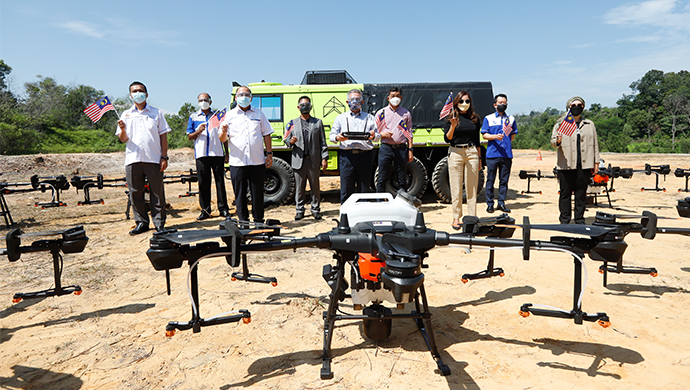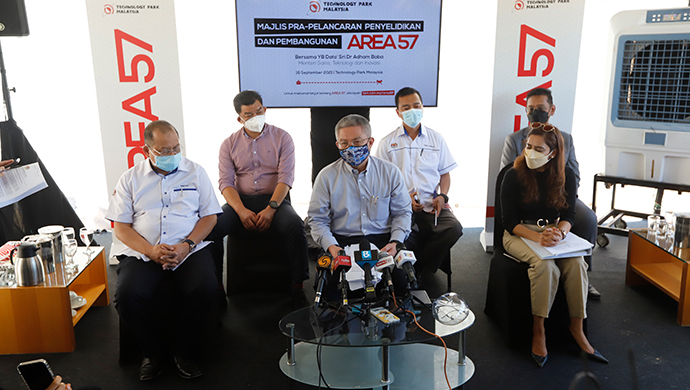
Earlier this week, Malaysia’s Aerodyne clinched the #1 spot globally for drone companies. In entrenching itself as a firm leader in this rapidly expanding market and by fostering the rise of more drone companies, Malaysia has ramped up several “live” drone test sites through the National Technology & Innovation Sandbox (NTIS).
Against a backdrop of a drone market revenue that is expected to double to US$17.9 billion in 2025 in Asia alone, as well as a global drone market forecast to achieve US$41.3 billion in 2026, it is clear that drone technology has captured a steadily rising audience.
Considered an emerging technology sector just a couple of years prior, momentum in drone technology is exciting as Malaysian players ready themselves to take on opportunities across the world. Such opportunities are exciting not only for the low-touch, high-tech development work involved but also for the jobs they create and the value they add to the economy.
Already, Malaysia has a few bright sparks in the drone industry.
The world’s top-seeded drone-based solutions provider in 2021, Aerodyne, for example, develops smart cities through drone technology innovation in surveillance and security, infrastructure development, and more.
The task at hand is to create a basket of such companies and expand the ecosystem so that we elevate the rewards and returns from such ventures.
Sandboxes for the skies?
In gaining a fast-mover advantage, Technology Park Malaysia, through the National Technology and Innovation Sandbox (NTIS), has taken proactive measures to foster the growth of the drone technology and robotics industry.
Today, several drone development areas in FELDA Mempaga, Pahang, Drone and Robotic Iskandar (DRZ Iskandar), and Urban Drone Delivery in Cyberjaya are in motion. Pilot projects here are aligned with the Ministry of Science, Technology and Innovation (MOSTI) 10-10 Science, Technology, Innovation, and Economy Framework (MySTIE 10-10), aimed at transforming Malaysia into a high-tech and high-income nation through innovation-based solutions.
Also read: Facebook Community Accelerator Program introduces the 19 communities of the 2021 APAC cohort
In the first year since its launch, the NTIS attracted more than 25 Malaysian companies developing drone technology, reaching out for regulatory, commercialisation, and funding support. The sandboxes provide a range of live sites where the drones can be tested for a variety of specific applications, on different terrains, for different ranges and more.
Ultimately, the value of drone services lies in how they are applied in various sectors such as e-commerce, logistics, or mobilisation of pertinent resources or medicine to rural, remote areas, or those affected by natural disasters. It also offers important value in infrastructure management and security surveillance in smart building maintenance, maritime surveillance, urban agriculture, and more. And this is where it gets exciting for the rakyat.

For this reason, Area 57 at Technology Park Malaysia was recently launched as the fourth drone-centred NTIS site. With an extensive 5 acres of land, Area 57 aims to provide an integrated ecosystem for key facilities and services which include research, development, testing, certification, manufacturing, commercialisation, and maintenance of drone technology and solutions in order to benefit the drone community of users and producers.
Area 57 will be equipped with a 100-meter drone runway, 300 square meters confined netted drone testing area, a mock-up site, drone application testing, hangar, laboratory, manufacturing equipment, training facilities, and prototype testing area, an operations office, as well as service and maintenance workshop for operators. It is currently the only legitimate fly-free drone area within Klang Valley. It is expected to unpack various opportunities through the use of Artificial Intelligence (AI) technology for data operations, analysis, and large-scale optimisation (Drone Tech, Data Tech & Digital Transformation).
Bright lights, smart cities
The current world population of nearly 8 billion is expected to reach 8.6 billion in 2030, 9.8 billion in 2050 and 11.2 billion in 2100 — sustainable smart cities are no longer just “nice-to-haves”. They are a necessity.
For example, the Drone & Robotics Zone (DRZ) at Iskandar, Johor, was formed to realise the vision of an integrated sustainable living area.
Here, technology and data are purposefully designed to make better decisions and deliver a better quality of life; from the air we breathe to how safe we feel when we walk along the streets at night.
Also read: ScaleUp Malaysia and e27: a partnership that could turn the tide for startups in the region
In order to accelerate the growth of IR4.0 in Malaysia, Iskandar NEXT (New Economic Experience & Talent), a flagship initiative by Iskandar Investment Berhad (IIB), has given rise to the DRZ Iskandar where there will be efforts to upskill local talents and to move them higher up the technology value chain, thus creating significant socio-economic impact, such as:
- Over RM351 million investments targeted by 2025.
- Up to 1000 high-value jobs created in drones and robotics by 2025.
- Over 70 technology companies set up business in Medini, creating highly skilled jobs and knowledge-sharing opportunities.
Already equipped with world-class ready-built infrastructure, IIB will further enhance Medini with advanced digital infrastructure to attract more tech-related companies to establish their footprint here.
At the core of it, our shared prosperity is the goal, and smart cities and drone technology are the means to that end. We want to utilise technology to optimise the infrastructure, resources, and spaces we share.
Better crops, support from the skies
The sandbox in FELDA Mempaga presents drone players an opportunity to advance agriculture technology in plantations for fertilisation, land monitoring, and weather monitoring. Here, drone technology is also assessed for its viability to support soil and field analysis, terrain mapping, crop spraying and planting, as well as plant health assessment and monitoring of yield.
Five high-technology companies — Poladrone, Aerodyne, Braintree Technologies, OFO Tech, and Nanoezinn — were selected to stress-test various drone and robotic solutions to improve aspects of harvesting, maintenance, and fertilisation of palm oil plantations at the 25-hectare site.
Recent discussions between drone service providers and the Civil Aviation Authority (CAAM) expedited the publishing of the Civil Aviation Directive 6011 part (II) Agriculture, which in turn opened doors for opportunities beyond these test sites.
With this unlocked, Poladrone, for example, is now currently providing spraying services for Kuala Lumpur Kepong Berhad, Sime Darby Plantations Berhad, Felda, Genting Plantations, and others. They’ve also doubled the company headcount and are on track to achieve revenue targets.
On a similar note, globally-acclaimed drone solutions provider, Aerodyne, has provided immense support in providing farmers with precision agriculture through drone technology and Artificial Intelligence to aid in increasing crop yields and profitability.
Though still in its early days, the use of drones and robotics in agriculture could potentially reduce up to 50 per cent in the labour force, generating up to 30 per cent in productivity improvement. At the same time, the application of drones in agriculture could set out career prospects for the younger generation in agriculture, whilst potentially improving the socio-economic outcomes for more than 200,000 ageing settlers working and living on Federal Land Development Authority (FELDA) land, with their families.
Smart logistics
Then, there is the Urban Delivery Drone Sandbox in Cyberjaya, where drones are being tested for delivery of packages, with the aim to use drones for the delivery of crucial medicines, essential supplies, and more to rural and remote areas, or those affected by natural disasters in the future.
Such delivery services could positively impact healthcare services, as 24 per cent of the country’s population lives in rural areas. With delivery drones, medicines, vaccines and necessary supplies can be transported to hard to reach areas quickly and efficiently.
Also read: Kawasaki Heavy Industries invites innovators to co-create solutions to global challenges
Earlier this year, NTIS partnered with AirAsia Digital’s logistics arm, Teleport, to test delivery services in urban areas using automated drones through a six-month phased approach. This approach tested the capability, experience, approval process, deployment readiness, and service expansion of the drone operators, as well as the long-term feasibility of delivery drones.
The urban delivery drones are estimated to make a contributing impact surpassing USD70 billion in the global smart mobility market size by 2027 and generate up to USD7.4 billion in global market size that is specific to drone package delivery by 2027.
Fly-tech: Challenges to overcome
In order for the industry to rise, there are some obstacles it needs to weather. Public safety guidelines being one.
As such, drone companies will need to abide by strict certification and compliance for drone operations, which may result in long periods for permits, limited guidelines for Beyond Visual Line of Sight (BVLOS) flights, and multi-agency approvals.
We laud the Civil Aviation Authority of Malaysia (CAAM) which has been actively engaging with drone operators to ensure public safety as a high priority in addition to facilitating technological advances.
Here, NTIS facilitates startup companies operating in regulated industries and vertical technologies such as healthcare, drone operations, agriculture, communications, mobility, etc. that face obstacles and challenges in terms of regulatory or innovation to accelerate such multi-agency discussions.
Without a doubt, drone technology development efforts must be intensified and we have set our sights on things above to take us on the path towards recovery, rising above the present-day challenges, and into a future of unlimited possibilities.
With better case studies and adaptive rules that drive innovation, we believe that TPM is poised to help Malaysia achieve its goal of becoming a major leader in the drone technology industry.
The game is afoot accelerating our STI journey and transforming our nations’ technology landscape. Be part of the revolution. Let’s take flight together.
– –
This article is produced by the e27 team, sponsored by MaGIC
We can share your story at e27, too. Engage the Southeast Asian tech ecosystem by bringing your story to the world. Visit us at e27.co/advertise to get started.
The post Blue skies for Malaysia’s drone industry with Aerodyne appeared first on e27.

